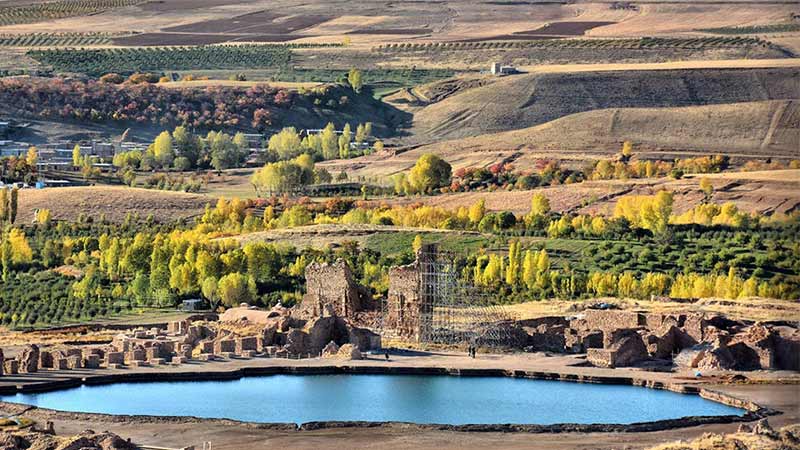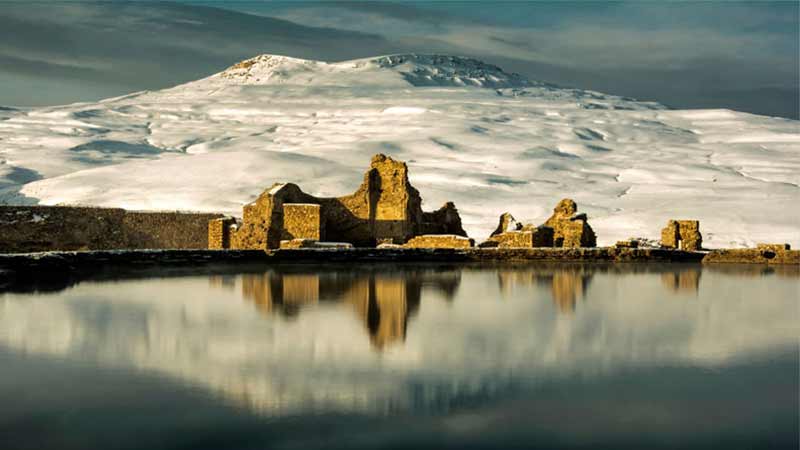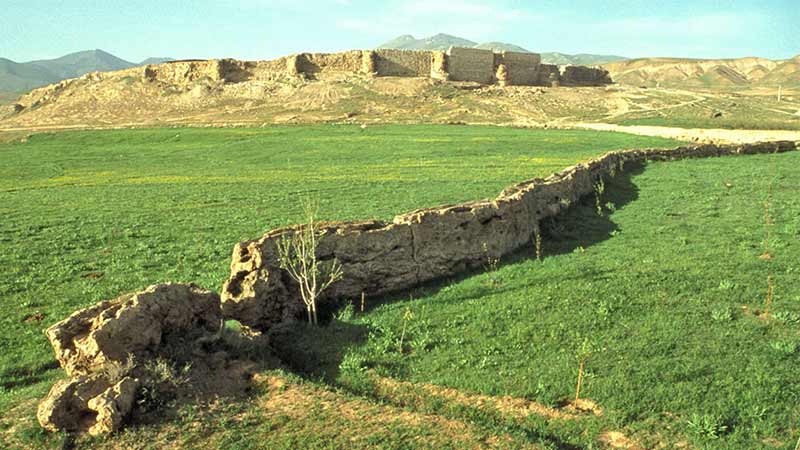Takht-e Soleyman, regarded as the birthplace of Zoroaster, has witnessed five eras of human history and civilization. This unique and extraordinary site, dating back 3000 years and listed in UNESCO’s World Heritage Sites, is one of the attractions of West Azerbaijan province of Iran and is located in the city of Takab. Takht-e Soleyman was the largest educational, religious, and worship center before Islam and is considered the most important base of the Zoroastrian religion. The World Heritage of Takht-e Soleyman includes various sections such as the Azargoshnasb Fire Temple, Khosrow’s Ivane, Anahita Temple, small fire temples, and more, which we will discuss in this article.
Takht-e Soleyman in Tekab
Takht-e Soleyman, referred to as “Shahr-e Ganjak” in Pahlavi writings, is located in a lush valley and is one of the attractions of Takab. According to some ancient texts, it is believed to be the birthplace of Zoroaster.
The ancient city of Takht-e Soleyman was the home of the Medes, Achaemenid, Parthian, Sassanian, and Mongol tribes, thriving in power throughout these periods. Takht-e Soleyman, dating back three thousand years, had an eternal fire representing the glory and authority of the Sassanian government and the Zoroastrian religion for seven centuries. In fact, this area was the largest religious education center and Zoroastrian Mobad training center during the Sassanian era. This complex was listed in Iran’s national monuments on December 20, 1937, and was registered as a World Heritage Site in July 2003, becoming the fourth Iranian site on UNESCO’s World Heritage List after Persepolis, Chogha Zanbil, and Naqsh-e Jahan Square.

History of Takht-e Soleyman
The buildings in the Takht-e Soleyman complex were constructed during different historical periods, namely Parthian, Sassanian, and Ilkhanid eras. Among the most important are the fire temple and halls from the Sassanian era; however, archaeological excavations have also found traces from the Achaemenid and Median periods.
The findings from Takht-e Soleyman tell the story of 3000 years of human habitation at this site. These artifacts not only belong to the Paleolithic era, Iron Age I, II, and III, but also show signs of settlement during the Scythian, Mannaeans, Medes, Achaemenids, and Parthians in Takht-e Soleyman. Remains of a residential village in the northwest of the lake, dated to the Achaemenid period, are one such example.
It is said that the order to build Takht-e Soleyman and its fire temple was given by Bahram Gur, one of the Sassanian kings; however, other Sassanian kings also contributed to its prosperity and development. Eventually, this site was destroyed in 624 AD during a Roman Empire attack. After the fall of the Sassanian government and the acceptance of Islam in Iran, the grand complex of Takht-e Soleyman did not regain its vitality.

Ilkhanid Era
With the arrival of the Ilkhanid Mongols, this site was used as a summer capital for the kings, evidenced by buildings dating back 700 years. During the rule of the Mongol Aqakhan in the 7th century Hijri, various structures such as the Eastern Ivane, Council Hall, eight and 12-sided buildings were added to the Takht-e Soleyman complex.
Lake of Takht-e Soleyman
In the Takht-e Soleyman site, you will encounter a natural lake with beautiful scenery, considered one of the wonders of Iran, with water gushing from a spring 120 meters deep. German divers were the first to enter the lake, but the sediments and water pressure did not allow them to find anything inside the lake.
Different Sections of Takht-e Soleyman
The historic Takht-e Soleyman complex is built around a beautiful lake, surrounded by an oval-shaped fence and wall. Inside this enclosure, two squares are visible, with a fire temple in the center of the northern square and the lake in the center of the southern square. Additionally, in the northwest of the lake, there is a high porch named Ivan-e-Khosrow, and in the southwest part outside Takht-e Soleyman, there is a stone channel known as “Dragon Stone,” approximately 1.5 to 2 meters high and 250 meters long. We will provide a brief explanation of the different parts of Takht-e Soleyman below.

Takht-e Soleyman Fence
The oval-shaped fence of Takht-e Soleyman, 1120 meters long, has 38 towers and served as a defensive barrier for the complex. This fence has been reconstructed over various periods; however, due to the passage of time and human damage, only the southeast gate’s entrance, parts of the walls, and more remain. Besides the northern gate, which was the city’s main entrance, and the southeast gate, the best-preserved gate of Takht-e Soleyman, an additional gate was added during the Ilkhanate era on the southern side, leading to a road for vehicle access and the current entrance for visitors.
At the southeast gate, seven stone mihrabs exist, symbolizing the seven guardian deities in Zoroastrianism. People would enter the complex by passing under these sacred signs.
Azargoshnasb Fire Temple
Takht-e Soleyman’s heyday dates back to the Sasanian period when one of the three significant fire temples of the era, named Azargoshnasb Fire Temple, was built here. It was also known as Azargushasp and Azarshasp. This fire temple was so important that every Sasanian king would visit it on foot after ascending the throne and offer a portion of their war spoils to the temple.
Sasanian kings visited Azargoshnasb during difficult times, vowing their gold, silver, and possessions to it. The fire temple was also known as “Azarkhosh”; “Azar” in ancient Persian means “fire,” and “khosh” means “good.” This temple symbolized the unity and solidarity of the central government with the Zoroastrian religion and was a symbol of the Sasanian state.
The Significance of Azargoshnasb Fire Temple During the Reign of Khosrow Anushirvan
The importance and prestige of this fire temple peaked during the reign of Khosrow Anushirvan. When he conquered Syria and Asia Minor, he brought the “True Cross of Christians” from Jerusalem to this site. In 624 AD, during the Roman army’s attack, which led to Khosrow Parviz’s soldiers’ defeat, the True Cross was returned to Jerusalem, and the city was destroyed by Heraclius’ orders. In fact, he destroyed the most sacred religious site of the Sasanians, the Azargoshnasb Fire Temple, in retaliation for Khosrow Parviz’s soldiers desecrating Jesus Christ’s tomb in Jerusalem. With the advent of Islam, this site lost its importance, although the fire temple was still used by Zoroastrians in a smaller scale until the 4th century AH. Later, Abaqa Khan of the Mongols conducted significant renovations in the area, constructing new buildings and using it as a recreational site.
Since the Sasanians believed that sacred fire should not be exposed to sunlight, the fire temple buildings were completely enclosed, with a four-arched dome roof. This was also true for the Azargoshnasb Fire Temple, consisting of various parts like a central square room for worship ceremonies, a fire altar at the center of the four-arch where only the chief priest had the right to approach the fire, a small brick four-arch for keeping the fire outside worship times, a treasury for gifts, votive offerings and spoils of war, living quarters for the priests, storehouses, religious schools, etc.
Ivan-e Khosrow
Ivan-e Khosrow or the Western Portico, located near the fire temple on the northwest side of the fortress, was probably built during the reign of Khosrow I, known as Anushirwan. However, an earthquake 80 years ago significantly damaged its muqarnas and arches.
This majestic Sassanian portico stands out like a gem in the heart of Takht-e Soleyman. Its purpose was for Sassanian kings to use during ceremonies and public audiences at the Azargoshnasb Fire Temple. Similar in design to the Ivan of Madain but smaller, it was made of red bricks and Sarooj mortar, measuring 12 meters wide and 27 meters deep. The remains suggest its height was about 18.5 meters. South of the Ivan is a structure known as Khosrow’s Dormitory, rumored to have a secret passage to the lake. Ivan-e Khosrow can be identified by the scaffolding erected 47 years ago for its protection.
Seven centuries after Heraclius destroyed Takht-e Soleyman, the Ilkhans restored it, incorporating their era’s techniques and decorations, like golden tilework and frescoes. Some examples are preserved in the National Museum of Iran.
Other ivans, of which only the bases remain, include the Southern, Northern, and Eastern Ivans. The Northern Ivan is also called the Coronation Ivan, as it’s believed kings were crowned there after purification with fire and water in the fire temple and Anahita temple.
Anahita Temple
The Anahita Temple, dedicated to the goddess of water and fertility, had a strong connection with the Azargoshnasb Fire Temple and Zoroastrianism. The temple’s base walls were made of polished gray stone, contrasting with the fire temple’s red brick. A shallow pool in the central courtyard beautifully reflected the sky.
Water from Takht-e Soleyman’s spring flowed to the back of the temple hall through channels. After seven stages of turbulence and noise reduction, fragrant liquids were added, and prayers were said over it. Thus, when the water reached the main pool, it was silent and mirrored the sky like a mirror.
The temple had arches and corridors for worshippers around the central courtyard, remnants of which still exist. Interestingly, no mortar was used in its construction, with the stones interlocked using a technique known as dry stone masonry.

Corridors of Takht-e Soleyman
Visitors entering through the northern gate, the main entrance to Takht-e Soleyman, would first encounter a vestibule and then two covered corridors to the right and left. Depending on their purpose – religious or administrative/political – they would choose one of these corridors. Besides guiding people through this vast complex, these corridors also created a protective and secure barrier around the structures and lake. Another purpose was to reduce the noise of political figures and soldiers’ movement in this sacred site.
The western corridor, turning 90 degrees, encompasses all sections of the Western Ivan. Much of this corridor remains, and walking through it leads to the columned hall and Ivan-e Khosrow.
A straight path also existed from the northern gate to the fire temple and lake center, presumably for royal entries or coronation ceremonies.
Ilkhanid Era Buildings
As mentioned, seven centuries after the Sassanids, the descendants of Genghis Khan revitalized Takht-e Soleyman. Newly converted to Islam, they incorporated their religious beliefs in the changes made, evident in the restoration of Ivan-e Khosrow and its tilework and plasterwork. The Ilkhanid period constructions include the southern gate, octagonal and dodecagonal structures, hunting palace, council hall, mosque, bathhouse, and industrial workshops.
Columned Hall
The columned hall, another Ilkhanid era structure, is believed by German archaeologists to have been a celebration and dining hall for kings. Located north of Ivan-e Khosrow and west of the Azargoshnasb Fire Temple, it had two rows of four columns. Interesting features include marks and signatures left by stonemasons on the hall floor, though only one is displayed in the east of the hall to protect its stone paving, covered with a layer of sand. This mark is a Swastika, a sun wheel, or a broken cross, an ancient symbol from the Mithraism era. Another columned hall exists south of this structure, with square-section columns, although much of it remains unexcavated and buried under Ilkhanid era palaces.

Octagonal Buildings
Two octagonal buildings west of Ivan-e Khosrow were constructed using stone, brick, and plaster mortar, with tilework and plasterwork in interior decorations. These structures, part of the Ilkhanid palaces of Takht-e Soleyman, are significant for their plan, interior decorations, doors, and attachment to Ivan-e Khosrow.
Council Hall
The Council Hall was used by the Ilkhanid kings and served as a place for making important national decisions. After the first phase of the restoration project of Takht-e Soleyman was completed, a museum was established to display historical artifacts found at the site. These include remnants of pottery and ceramic grenades, bone whistles, decorative stone beads, sections of decorations and tilework, ancient pottery jars, bowls, and more. Additionally, images of exploratory excavations and restorations over the past 48 years, as well as aerial photos by Schmidt, marking the start of archaeological excavations, are on display here.

Best Time to Visit Takht-e Soleyman
Takht-e Soleyman is a beautiful destination in every season, but the best time to visit is during spring and early summer, from April to June. During these months, the weather is still cool, and the surrounding mountains and nature are green and covered with colorful flowers.
Conclusion
Parts of the Takht-e Soleyman complex are illuminated at night, making a night walk and photography of its beauty a delightful experience. If you have visited Takht-e Soleyman, feel free to share your experiences at the comment section below.



